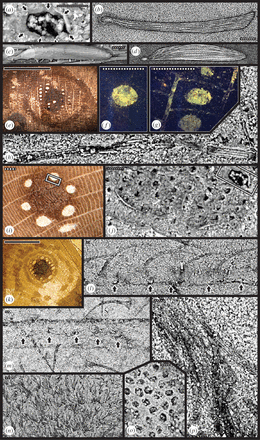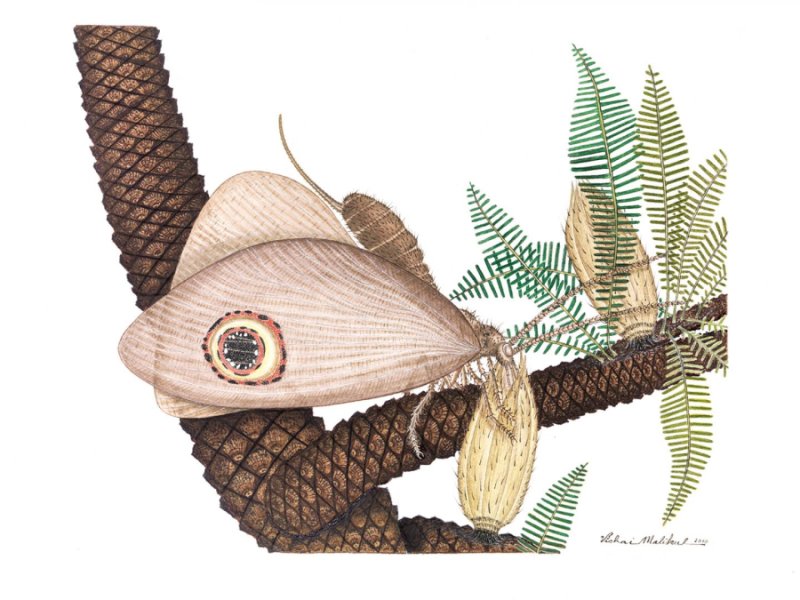IU paleobotanist David Dilcher is a co-author on a study out today in the Proceedings of the Royal Society: B that identifies a Jurassic age insect whose behavior and appearance closely mimic a butterfly — but whose emergence on Earth predates the butterfly by about 40 million years.
Dilcher — who made international headlines last year for his role in discovering the mythical “first flower” — said these proverbial “first butterflies” survived in a similar manner as their modern sister insects by visiting plants with “flower-like” reproductive organs producing nectar and pollen.
The butterfly-like insects, which went on to evolve into a different form of insect from the modern butterfly, is an extinct “lacewing” of the genus kalligrammatid called Oregramma illecebrosa. Another genus of this insect — of the order Neuroptera — survives into our modern era, and are commonly known as fishflies, owlflies or snakeflies.
![Kalligrammatid structural diversity. Specimens are from the late-Middle Jurassic Jiulongshan Fm. (JIU), China; Late Jurassic Karabastau Fm. (KAR), Kazakhstan; and mid-Early Cretaceous Yixian Fm. (YIX), China (electronic supplementary material, tables S2 and S3). At (a–i) are nine species showing general habitus [11]. Arrows indicate proboscis tips. (a) Kalligramma circularia (JIU); (b) Affinigramma myrioneura (JIU); (c) A. myrioneura (JIU); (d) Kallihemerobius feroculus (JIU); (e) Oregramma aureolusa (YIX); (f) Ithigramma multinervia (YIX); (g) Abrigramma calophleba (JIU); (h) Kalligramma brachyrhyncha (JIU); and (i) Oregramma illecebrosa (YIX). (i–k) Lateral views of ovipositor structure in O. illecebrosa above: (i) intact specimen; (j) complete ovipositor and posteriormost abdominal segments; and (k) lateral valve pairs. (l–q): five kalligrammatid wing eyespot and spot types detailed in figures 2 and 3; electronic supplementary material, figure S1. (l) Type 1 wing eyespot with two outer rings and ca 15 contiguous ocules surrounding a central pigmented disc (O. illecebrosa, YIX); (m) Type 2 wing eyespot with a single outer ring, light-hued inner area, and uninterrupted, pigmented central disc with surrounding, non-contiguous ocules (Kallihemerobius almacellus, JIU); (n) Type 2 eyespot similar to (M) (Kallihemerobius feroculus, JIU); (o) Type 3 wing eyespot with a light-hued circular area and a few, variably sized ocules in a darkly pigmented central disc (Ithigramma multinervia, YIX); (p) Type 4 wing eyespot contains a few ocules and others surrounding a pigmented central disc, a light-hued inner area and surrounding, dark outermost ring (K. circularia, JIU); and (q) Type 5 wing spot of a circular, pigmented central disc (Kallihemerobius aciedentatus, JIU). Scale bars: solid, 10 mm; striped, 1 mm.](http://www.worldfossilsociety.org/wp-content/uploads/2016/02/151209183454_1_540x360-1-1024x798.jpg)
Kalligrammatid structural diversity. Specimens are from the late-Middle Jurassic Jiulongshan Fm. (JIU), China; Late Jurassic Karabastau Fm. (KAR), Kazakhstan; and mid-Early Cretaceous Yixian Fm. (YIX), China (electronic supplementary material, tables S2 and S3). At (a–i) are nine species showing general habitus [11]. Arrows indicate proboscis tips. (a) Kalligramma circularia (JIU); (b) Affinigramma myrioneura (JIU); (c) A. myrioneura (JIU); (d) Kallihemerobius feroculus (JIU); (e) Oregramma aureolusa (YIX); (f) Ithigramma multinervia (YIX); (g) Abrigramma calophleba (JIU); (h) Kalligramma brachyrhyncha (JIU); and (i) Oregramma illecebrosa (YIX). (i–k) Lateral views of ovipositor structure in O. illecebrosa above: (i) intact specimen; (j) complete ovipositor and posteriormost abdominal segments; and (k) lateral valve pairs. (l–q): five kalligrammatid wing eyespot and spot types detailed in figures 2 and 3; electronic supplementary material, figure S1. (l) Type 1 wing eyespot with two outer rings and ca 15 contiguous ocules surrounding a central pigmented disc (O. illecebrosa, YIX); (m) Type 2 wing eyespot with a single outer ring, light-hued inner area, and uninterrupted, pigmented central disc with surrounding, non-contiguous ocules (Kallihemerobius almacellus, JIU); (n) Type 2 eyespot similar to (M) (Kallihemerobius feroculus, JIU); (o) Type 3 wing eyespot with a light-hued circular area and a few, variably sized ocules in a darkly pigmented central disc (Ithigramma multinervia, YIX); (p) Type 4 wing eyespot contains a few ocules and others surrounding a pigmented central disc, a light-hued inner area and surrounding, dark outermost ring (K. circularia, JIU); and (q) Type 5 wing spot of a circular, pigmented central disc (Kallihemerobius aciedentatus, JIU). Scale bars: solid, 10 mm; striped, 1 mm.
![Phylogenetic context of wing spots and eyespots in mid-Mesozoic kalligrammatids, with comparisons to modern lepidopterans (electronic supplementary material, text S3). The best preserved fossil material was used for this analysis. (a) Most parsimonious tree of Kalligrammatidae phylogeny [11] (electronic supplementary material, table S2), with right forewing eyespot/spot condition mapped onto terminal clades and likely wing spot and eyespot origins. Wing eyespot and spot type symbols are at upper-left; crosses are eyespot/spot absences. (b–g) Examples of right forewings with wing eyespots or spots from mid-Mesozoic Kalligrammatidae (b–f), and modern Psychopsidae (g). These taxa correspond to a Type 1 eyespot (b), Type 2 eyespot (c), Type 3 eyespot (d), Type 4 eyespot (e) and two Type 5 double spots (f) matched by two spots in modern psychopsid (red arrows) in (g). Kalligrammatid wing eyespots and spots are compared to modern Lepidoptera in (h–k), of butterfly species with Type 6 eyespots (h) and multiple Type 5 spots (i); moth lacking wing spots or eyespots (j); and modern owl butterfly eyespot (k), showing pigmentation similar to Type 2 and 3 eyespots (b), indicated by arrow pointing to an ocule series and longitudinal wing vein. Scale bars: solid, 10 mm; striped, 1 mm.](http://www.worldfossilsociety.org/wp-content/uploads/2016/02/151209183454_1_540x360-2-1024x822.jpg)
Phylogenetic context of wing spots and eyespots in mid-Mesozoic kalligrammatids, with comparisons to modern lepidopterans (electronic supplementary material, text S3). The best preserved fossil material was used for this analysis. (a) Most parsimonious tree of Kalligrammatidae phylogeny [11] (electronic supplementary material, table S2), with right forewing eyespot/spot condition mapped onto terminal clades and likely wing spot and eyespot origins. Wing eyespot and spot type symbols are at upper-left; crosses are eyespot/spot absences. (b–g) Examples of right forewings with wing eyespots or spots from mid-Mesozoic Kalligrammatidae (b–f), and modern Psychopsidae (g). These taxa correspond to a Type 1 eyespot (b), Type 2 eyespot (c), Type 3 eyespot (d), Type 4 eyespot (e) and two Type 5 double spots (f) matched by two spots in modern psychopsid (red arrows) in (g). Kalligrammatid wing eyespots and spots are compared to modern Lepidoptera in (h–k), of butterfly species with Type 6 eyespots (h) and multiple Type 5 spots (i); moth lacking wing spots or eyespots (j); and modern owl butterfly eyespot (k), showing pigmentation similar to Type 2 and 3 eyespots (b), indicated by arrow pointing to an ocule series and longitudinal wing vein. Scale bars: solid, 10 mm; striped, 1 mm.
Based on their examination, which drew in part upon microscopically small clues such as the fossilized remains of food and pollen trapped in the mouthparts of the insects, Dilcher and colleagues concluded kalligrammatid fed upon bennettitales using a long tongue to probe nectar deep within the plant. The insects also possessed hairy legs that allowed for carrying pollen from the male flower-like reproductive organs of one plant to the flower-like female reproductive organs of another.

Microstructure of three kalligrammatid forewing eyespot types and their cuticular scales. (a) Kalligrammatid ellipsoidal wing-scale socket retains a broken scale base in cross-section of four lower (bottom arrows) and three upper (top arrows) ribs, enlarged from upper-right of (j). This socket type receives distinctive flat scales on major veins present elsewhere on the wing, depicted as an overlay drawing in (b), showing four longitudinal ribs basally and eight ribs terminally on Kalligramma sp. (JIU). For comparison of (b), at (c) and (d) is a foreleg scale of the modern neuropteran Lomomyia squamosa (Berothidae) (electronic supplementary material, text S2), in a SEM at left (c) and overlay drawing at right (d). (e–h) A Type 4 eyespot of Kalligramma circularia (JIU). (e) Light photograph showing eyespot pigmentation pattern, with epifluorescence microscopy revealing a differently pigmented ocule (f), and three additional ocules (g), each in a wing compartment surrounded by minor veins bearing flattened, four-ribbed scales, four shown in the SEM at (h). (i) Light photograph of a Type 2 eyespot of Kallihemerobius almacellus (JIU), showing seven whitish hued ocules surrounding a central pigmented disc, the boundary (template) shows smaller empty scale sockets in interveinal areas and occasional larger scale sockets on veins in the SEM at (j). Large wing-scale socket at upper-right enlarged at (a). (k–n) and (p) A light photograph of a Type 1 eyespot (k) from Oregramma illecebrosa (YIX), with dark pigmented central disc surrounded by whitish ocules and two dark outer rings. (l) SEM detail of four curved scales, each socketed on a longitudinal vein; black arrows indicate alternating sockets that lack scales. (m) Nearby scales. (n) Field of clumped scales on a wing region lacking veins and eyespots and a fascicle of eight, large, detached scales in (p), each displaying a ridged structure. Eyespot ocule at (o), from Kallihemerobius aciedentatus (JIU), shows a regular array of interveinal scale sockets, structurally distinct from central-disc pigmented regions, bearing scales socketed on major veins. See electronic supplementary material, table S2 for specimen data; scale bars: solid, 10 mm; striped, 1 mm; dotted, 10 µm.
Eventually, this system of pollination by long-tongued lacewings traveling between plants with exposed reproductive parts — called gymnosperms — gave way to more familiar system of insect pollinators and modern flowers, or angiosperms, in which the reproductive parts of the plants are contained with a protective seed.
However, another evolutionary innovation found in the ancient lacewing fossils’ wings remained remarkably unchanged over the course of millennia: so-called “eye spots.”

This is an artist’s rendering of Oregramma illecebrosa consuming pollen drops from bennettitales, an extinct order of plant from the Triassic period. Credit: Vichai Malikul
This unique pattern on the wings, arising over 200 million years ago, is nearly identical to markings on the modern owl butterfly. To this day, owl butterflies use these circular marks as a defense mechanism against predators, which mistake the spots as the eyes of a larger, more threatening animal.
Evolution is a great innovator, Dilcher said. But at the same time: “if it worked once, why not try it again.”
This work was supported in part by the National Basic Research Program of China, National Science Foundation of China, National Institutes of Health and Swedish National Space Board.
Courtesy: Indiana University. “Discovery of ‘Jurassic butterflies’.” ScienceDaily. ScienceDaily, 3 February 2016. <www.sciencedaily.com/releases/2016/02/160203134942.htm
WFS,Riffin T sajeev,Russel T sajeev,World Fossil Society



 February 4th, 2016
February 4th, 2016  Riffin
Riffin  Posted in
Posted in  Tags:
Tags: 